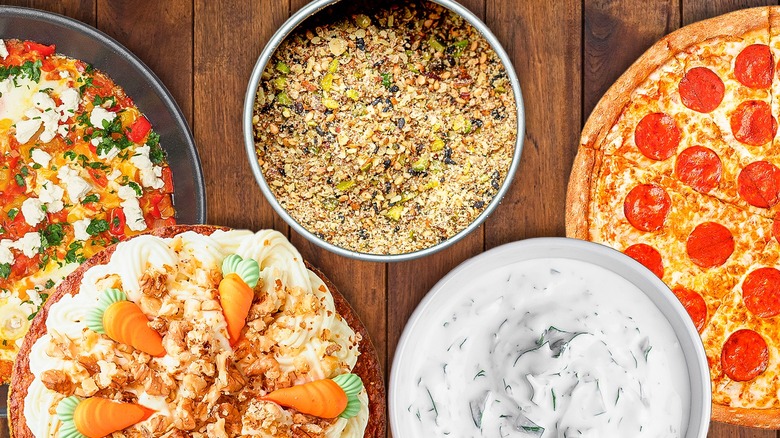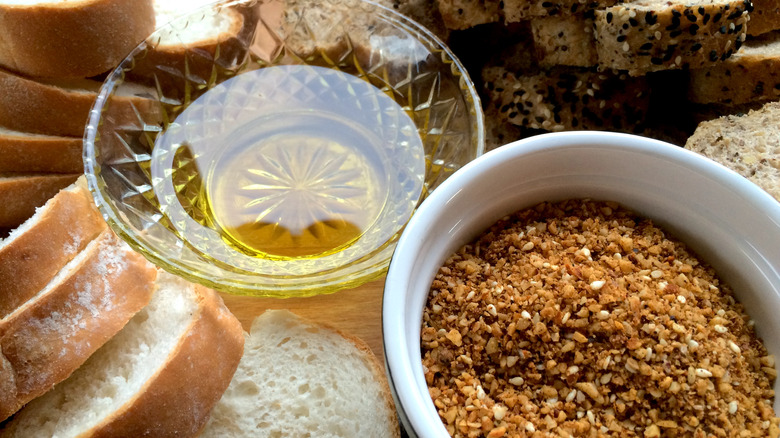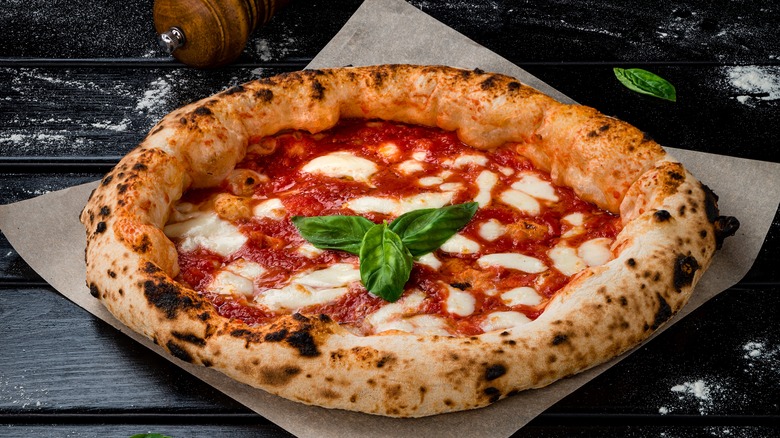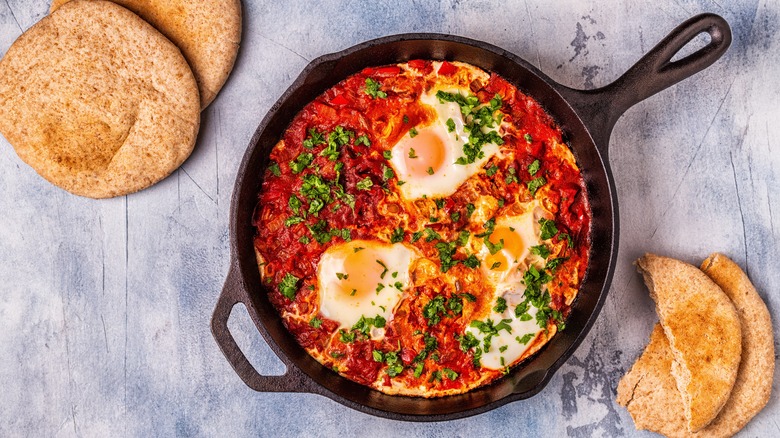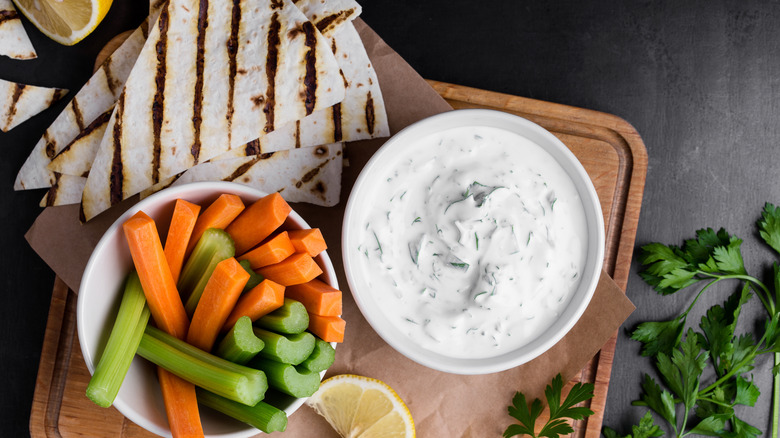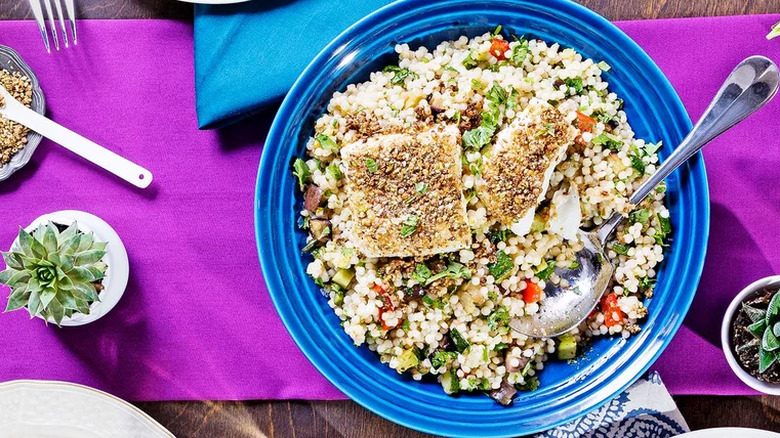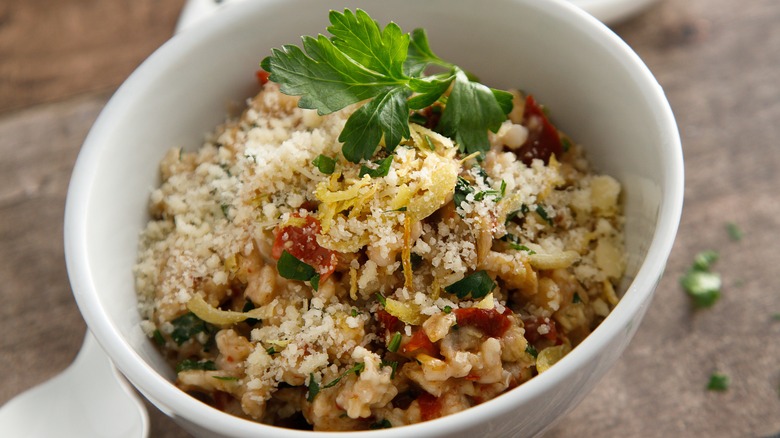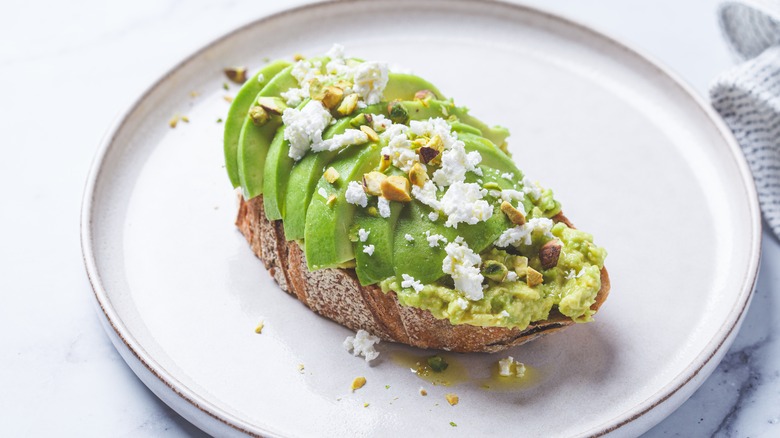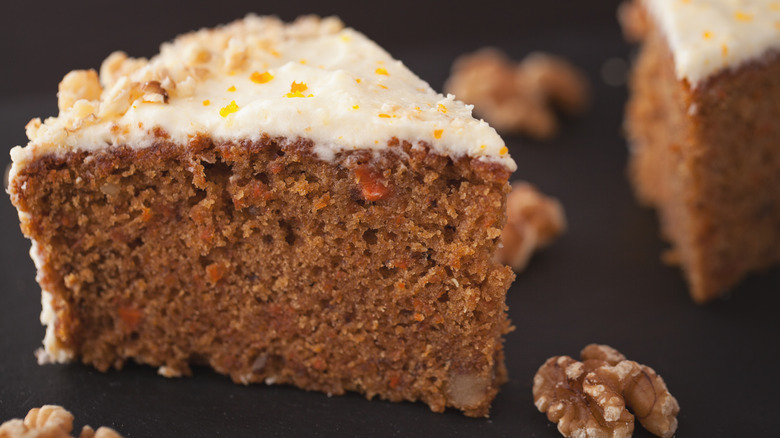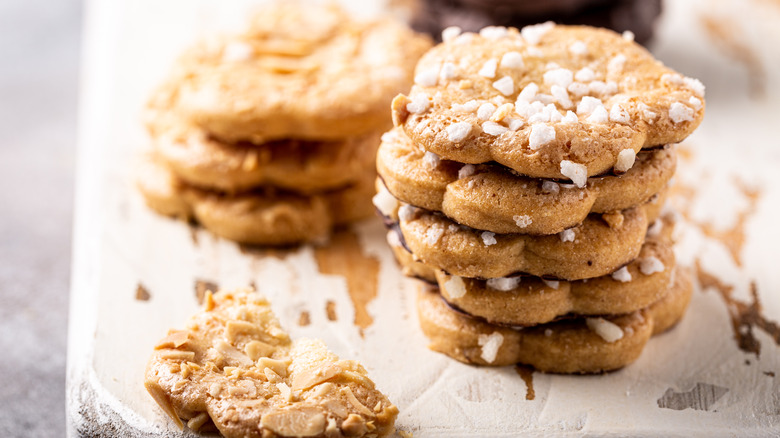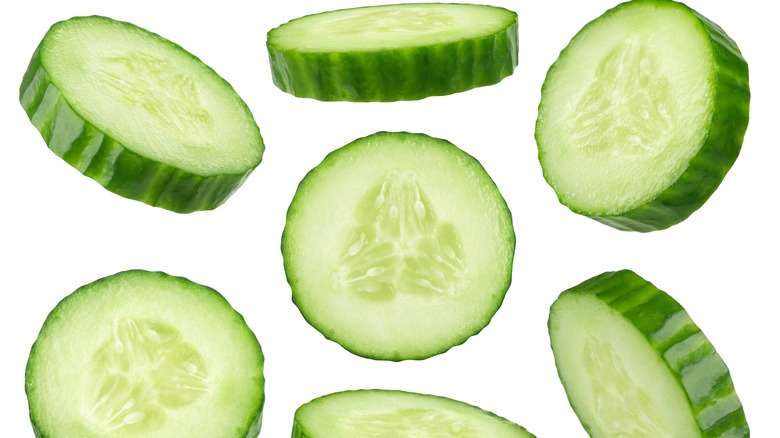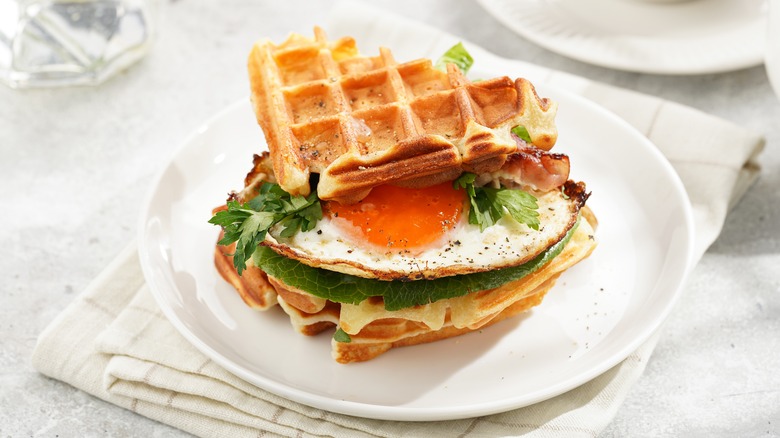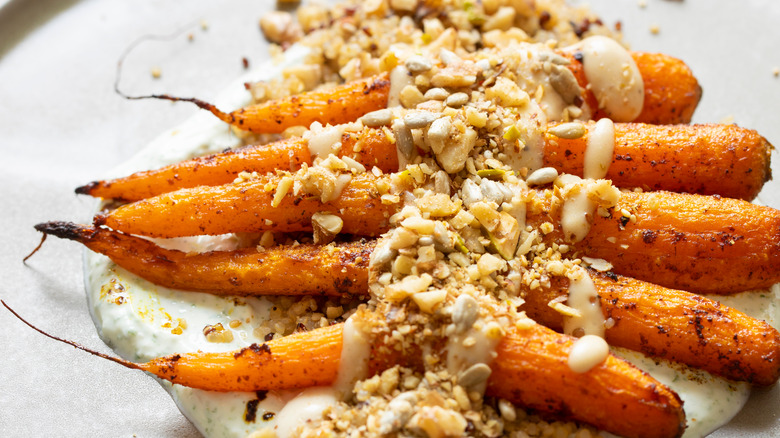12 Creative Ways To Use Dukkah In Your Cooking
If you've never heard of or cooked with dukkah before, you're in for a treat. This toasted nut and spice blend is complex, salty, and full of flavor. Think of it as a savory sprinkle that you can throw on anything to make it instantly better. Hailing from Egypt, dukkah is usually made with one or several types of toasted nuts like peanuts, almonds, hazelnuts, and pistachios, which are often ground into a chunky powder consistency. The choice of nuts is usually determined by what's currently available or simply down to preference.
In Egyptian cuisine, warm spices like cumin and coriander are prominent, and it's no different with dukkah which, while different blends may vary, usually always includes both. Dukkah also always includes toasted sesame seeds, which, along with the chunkier pieces of nuts, provide a pleasant crunchy texture. Finally, dukkah includes a generous amount of salt to make it complete on its own and enable it to be used as a seasoning.
As a food writer with Egyptian heritage, I grew up snacking on dukkah and throwing it on different dishes. The best thing about it is how customizable it is, and I regularly make my own fresh batch at home, depending on what's in my pantry. There are countless ways to enjoy dukkah and once you discover it, you're likely going to be creating your own pairings since it goes well with so many foods. Here are some creative ways to use dukkah in your cooking.
Bread dipping oil
Whether you buy a ready-made blend or make your own dukkah at home, a good introduction to this spice blend is to simply enjoy it on some bread. This is traditionally how it's eaten in Egypt, and it makes for an affordable and easy salty snack whenever the craving hits. You can also use dukkah as a way to upgrade your bread dipping oil. You can mix dukkah with good quality olive oil for a delicious oil to dip your bread into, or you can serve the oil and dukkah in separate dipping bowls. You dip some bread into the olive oil first, and then into the dukkah. The oil helps the dukkah stick to the bread.
The nuts and seeds, which have both protein and fats, along with the added olive oil, make it a little more filling than eating something like potato chips, so it's the perfect pick-me-up in the afternoon. If you can get your hands on simit bread, then you can have the full authentic experience, as this sesame seed-coated bread, often shaped in a thin ring, is the traditional bread for dipping into dukkah in Egypt. You can also use an infused oil like garlic or truffle oil to make your dipping oil extra tasty — although you'll likely find the dukkah has all the flavor you need.
Pizza topping
This may seem a little out of the ordinary, but dukkah is a delicious pizza topping. It not only adds a little more spice and seasoning to your slice, but also gives it a little crunch. Pizza makes for the perfect base as, depending on the toppings, it can be a blank slate for added flavor, or dukkah can be a way to enhance the other toppings. If you're making your own pizzas or reheating them at home, it's best to add dukkah once the pizza is out of the oven. As the nuts are already toasted, you don't want to run the risk of them burning in the oven. The dukkah sticks to the hot mozzarella with ease if you sprinkle it on top, and you can also dip your slice into the nut mix if you prefer.
If you go with a plain Margherita pizza it will work a treat, but you can also play around with toppings that might suit the flavors of cumin. Ground meat and onions would be delicious, or other toppings like mushrooms, olives, sausage, and pepperoni would work well. If you're inclined to the sweet and salty appeal of pineapple on pizza, sprinkling a little dukkah on top would give it a surprising edge, too.
Shakshuka
If you're a fan of an egg breakfast, shakshuka is a must-try. This North African dish of eggs poached in a spiced tomato sauce is a wonderful recipe to master, as it creates a satisfying meal that can feed a few mouths with just a handful of ingredients that you may already have in your fridge. There are various topping options for shakshuka, and you can add anything from feta cheese, olives, or fresh herbs like cilantro and parsley. Dukkah should be added to this list, too, as the flavors of the nuts and spices complement those of the shakshuka and take an already tasty dish to new heights.
If you plan to use dukkah on your shakshuka, you can even forego the spices while cooking your tomato base since the dukkah will provide those flavors regardless. In truth, dukkah is a wonderful topping for all types of eggs, including fried eggs, scrambled eggs, or boiled eggs. In fact, boiled eggs were never bland growing up as I always had a little bowl of dukkah to dip my hard-boiled eggs into.
Yogurt dip
Dukkah is a handy ingredient to have when you want to make a quick dip for an appetizer platter or afternoon nibble. Adding some dukkah into a bowl of yogurt makes an instant yogurt dip that's complex and tasty, with just two ingredients. The spices mix into the yogurt and create a creamy, savory dip with a slight nuttiness. You really don't need to add much else, but if you want to be a little extra fancy, a little splash of olive oil and fresh parsley will make your yogurt dip restaurant-worthy.
Dukkah is also great on other dips — you can sprinkle some on guacamole, or even some whipped feta or cottage cheese. Whatever dip you end up making, you can also sprinkle dukkah as a garnish, as it can add a striking visual topping as well as some crunch. Use some raw carrots or crudités or some toasted pita chips to dunk into your dip and enjoy the dynamic flavors and textures.
Dukkah crusted grilled fish
Dukkah can be used in your cooking beyond as a topping or sprinkle. It makes for a good choice when you want to create a spiced "crust" for a piece of grilled fish. In my experience, cumin is one of the most popular spices for cooking fish in Egypt, so dukkah is a natural pairing for fish. The nuts and seeds help to build the body of the crust, while the salt and spices season the fish and add flavor.
To make this dukkah-crusted halibut recipe, simply pat the fish filets dry and then rub them with some olive oil. Then, using your hands, pack some dukkah to the top of the filet. An added benefit of using dukkah on the bottom side of the fish is that it helps prevent the fish from sticking to your dish or parchment paper. You don't have to stop at fish either; you can use the same technique to make a dukkah crust for a rack of lamb, a pork chop, or other types of seafood like lobster tails. The possibilities are endless.
Savory oats
A bowl of warm oatmeal in the morning can be the perfect way to start the day with an energy-packed breakfast. It's an affordable but satiating food that can keep you full for longer and the best part is choosing your toppings, whether to go with fruit, chocolate, peanut butter, maple syrup, and more. However, for people who don't necessarily want to start the day with a sweet breakfast, you can opt for savory oats instead. It may be a new concept for you, but savory oats have become a more popular option as people have experimented with salty toppings instead of sweet, even cooking oats with chicken or vegetable broth instead of water or milk. When it comes to choosing a topping for savory oatmeal, dukkah is a no-brainer. Nuts and oats go together with ease, and a hit of salt and warm savory spices like cumin and coriander can be reminiscent of adding cinnamon to sweet oats.
The best thing about sprinkling dukkah on a bowl of savory oats is that the seeds and nuts add more crunch to the otherwise soft and one-note (in terms of texture) dish. This is especially the case if you like making a chunkier dukkah mix.
Avocado toast
For all the love for avocado toast out there, when you think about it, it can be a pretty plain-tasting dish. Toast with avocado is a great blank page you can use to play around with different toppings and spices to make it taste more exciting. Whether you prefer to lay out neat avocado slices on your toast or you like smashing them into a spread, dukkah is an easy topping for making your toast taste great. The avocado flesh works as an adhesive for the dukkah, and the mild avocado flavor is enhanced by the addition of the salt and spices. Plus, ground cumin and coriander are sometimes mixed into guacamole, so the flavors of avocado and dukkah work the same way.
The toasted nuts and seeds give your avocado toast some crispness, too, and make the dish more interesting texturally. You can add some black sesame seeds into your dukkah mix to make your toast look prettier, and it's an affordable way to enjoy something that might be served for a higher price at a cafe or brunch spot.
Carrot cake topping
Dukkah may seem like a strange thing to use as a carrot cake topping, but it actually works really well if you make a sweet version. In trendier cafes and stores, you can find sweet dukkah blends, or you can make your own, using the same concept as making a savory dukkah. The nuts and seeds can go both ways, but you can replace salt with sugar, and cumin and coriander with cinnamon or ginger to make a sweet, crunchy dukkah-inspired sprinkle. This makes it possible to add dukkah to desserts.
Some play on the sweet and savory elements by including some fennel seeds or even a hint of cumin and salt with the sweeter ingredients. Carrot cake is the perfect baked good to add a sweet or even savory dukkah to, as the cake batter already has nuts and some warm spices, which the flavors of dukkah would tie into beautifully. The dukkah sticks to the carrot cake frosting, adding flavor, crunch, and decoration. This could become your new favorite way to spruce up your carrot cake.
Sprinkled on shortbread
There are so many ways to play around with the concept of dukkah and you can mix and choose the flavors you like to include sweeter elements. Sweet dukkah can be really tasty on baked goods like muffins, pancakes, and more. However, if you like the play between salty and sweet, you might enjoy using a savory dukkah on a sweet treat like shortbread or other types of cookies. Shortbread makes a great carrier for dukkah, because other than the dreamy buttery flavor, it is mostly neutral in taste. Dukkah adds a lot more flavor to it and makes for an interesting bite.
As long as you're not excessive in the amount of dukkah you add, the sweetness of the shortbread won't be taken away. In fact, it may become a more balanced bite as the salty dukkah takes the edge off of the hit of sugar, much like something like salted caramel does.
The other reason dukkah works on shortbread is the texture. Shortbread is a crumbly cookie, and dukkah gives you a similar crumbly experience in your mouth. So next time you make a batch of shortbread, give it a sprinkle of dukkah to finish it off just as the cookies come out of the oven.
On cucumber slices
In warmer weather, people often crave cold foods like popsicles, watermelon, or raw veggies to snack on. Crunchy veggies like carrots, cucumbers, radishes, and bell peppers are a good choice as they're crunchy, tasty, and easy to prepare — if not a little on the boring side. While dips can be a great way to enjoy them, dukkah is another easy way to spruce up your raw veggies in no time. A childhood specialty in my household was cucumber slices with dukkah on top. These were refreshing, tasty, and so simple to make. They're so good for you in the summer, because cucumbers have a high water content and are hydrating, while dukkah gives you a little protein and fat from the nuts and seeds.
These little slices would keep us satiated between lunch and dinner time, and we could whip them up as we wanted. Simply cut a couple of slices of cucumber to your desired thickness (I like mine to be about an inch thick). Then using your hands or a teaspoon, evenly sprinkle the dukkah on each slice. You'll definitely need to use your fingers to pick them up and enjoy crunching on them until you've had enough. You're likely going to end up preparing some more as soon as you're done.
Savory waffles
It's hard to find someone who doesn't like waffles, and one of the best things about them is that you can get both sweet and savory varieties. Their crispy, chewy texture is a pleasure to bite into, and they can hold any topping you like. The fun comes in choosing what to top waffles with, and if you're going for savory waffles, dukkah is a tasty topping. It can be a delicious finishing sprinkle to fried chicken and waffles or an eggy waffle breakfast, but you can just as well have a plain waffle topped with dukkah for a savory snack in minutes.
Just like adding a crunchy nut topping to a sweet waffle, dukkah adds a nutty taste and feel, with added delicious spices to boot. The little dips in waffles catch the sprinkle and make an effective holding space for it to collect so that you can get crunchy bites throughout, making it the perfect vessel. You can also combine some of the pairings on this list by throwing on a dukkah yogurt sauce on top, or even make an "avocado toast" with a waffle base topped with some dukkah. It's all up to your preferences and creativity.
Roasted carrots
You may have come across dukkah before in a restaurant, and one popular way that chefs like to use it is to throw it on roast vegetables. Soft, caramelized veggies topped with a dusting of nutty crunchiness is a match made in heaven. This may look like a fancy dish, but in fact, it's simple to make, and you can easily recreate it at home. A good place to start is with roasted carrots because carrots and cumin are a great pairing. The earthiness of the carrots matches that of the dukkah and the added sweetness from roasting the carrots creates a wonderful balance.
To make dukkah roasted carrots, you proceed with roasting your carrots as you usually would. It doesn't matter whether you keep them whole or slice them into thinner pieces as long as they have a little bit of surface area to hold a sprinkle. The dukkah doesn't enter the oven, but once the carrots come out of the oven, sprinkle the dukkah on top while they're still hot. You can do the same with any vegetables you like to roast. A little trick I like to do is to glaze the carrots with a little honey first before sprinkling the dukkah — this makes it a little sweeter but also acts as a glue for the dukkah to stick to. You can also make a little dukkah yogurt sauce to lay the carrots on top of and finish off with extra dukkah on top.
